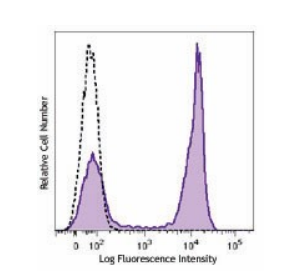
- 品名: Brilliant Violet 510? anti-mouse/human CD45R/B220 Antibody
- 型號: 103248
- 產品詳情
- 規(guī)格參數
Product Details
Isotype Control
Verified Reactivity
Mouse, Human
Reported Reactivity
Cat
Antibody Type
Monoclonal
Host Species
Rat
Immunogen
Abelson murine leukemia virus-induced pre-B tumor cells
Formulation
Phosphate-buffered solution, pH 7.2, containing 0.09% sodium azide and BSA (origin USA).
Preparation
The antibody was purified by affinity chromatography and conjugated with Brilliant Violet 510? under optimal conditions.
Concentration
μg size: 0.2 mg/mL
μL size: lot-specific (to obtain lot-specific concentration, please enter the lot number in our Concentration and Expiration Lookup or Certificate of Analysis online tools.)Storage & Handling
The antibody solution should be stored undiluted between 2°C and 8°C, and protected from prolonged exposure to light. Do not freeze.
Application
SB - Reported in the literature, not verified in house
Recommended Usage
Each lot of this antibody is quality control tested by immunofluorescent staining with flow cytometric analysis. For flow cytometric staining using the μl size, the suggested use of this reagent is 5 μl per million cells in 100 μl staining volume or 5 μl per 100 μl of whole blood. For flow cytometric staining using the μg size, the suggested use of this reagent is ≤0.5 μg per million cells in 100 μl volume. It is recommended that the reagent be titrated for optimal performance for each application. It is recommended that the reagent be titrated for optimal performance for each application.
Brilliant Violet 510? excites at 405 nm and emits at 510 nm. The bandpass filter 510/50 nm is recommended for detection, although filter optimization may be required depending on other fluorophores used. Be sure to verify that your cytometer configuration and software setup are appropriate for detecting this channel. Refer to your instrument manual or manufacturer for support. Brilliant Violet 510? is a trademark of Sirigen Group Ltd.
Learn more about Brilliant Violet?.
This product is subject to proprietary rights of Sirigen Inc. and is made and sold under license from Sirigen Inc. The purchase of this product conveys to the buyer a non-transferable right to use the purchased product for research purposes only. This product may not be resold or incorporated in any manner into another product for resale. Any use for therapeutics or diagnostics is strictly prohibited. This product is covered by U.S. Patent(s), pending patent applications and foreign equivalents.Excitation Laser
Violet Laser (405 nm)
Application Notes
Clone RA3-6B2 has been described to react with an epitope on the extracellular domain of the transmembrane CD45 glycoprotein which is dependent upon the expression of exon A and specific carbohydrate residues. Additional reported applications (for the relevant formats) include: immunoprecipitation1, in vitro and in vivo modulation of B cell responses2-4, immunohistochemistry of acetone-fixed frozen sections and formalin-fixed paraffin-embedded sections5,6, and spatial biology (IBEX)14,15.
Additional Product Notes
Iterative Bleaching Extended multi-pleXity (IBEX) is a fluorescent imaging technique capable of highly-multiplexed spatial analysis. The method relies on cyclical bleaching of panels of fluorescent antibodies in order to image and analyze many markers over multiple cycles of staining, imaging, and, bleaching. It is a community-developed open-access method developed by the Center for Advanced Tissue Imaging (CAT-I) in the National Institute of Allergy and Infectious Diseases (NIAID, NIH).
Application References
(PubMed link indicates BioLegend citation)Coffman RL. 1982. Immunol. Rev. 69:5. (IP)
George A, et al. 1994. J. Immunol. 152:1014. (Activ)
Asensi V, et al. 1989. Immunology 68:204. (Activ)
Domiati-Saad R, et al. 1993. J. Immunol. 151:5936. (Activ)
Hata H, et al. 2004. J. Clin. Invest. 114:582. (IHC)
Monteith CE, et al. 1996. Can. J. Vet. Res. 60:193. (IHC)
Shih FF, et al. 2006. J. Immunol. 176:3438. (FC)
Chang C L-T, et al. 2007. J. Immunol. 178:6984.
Fazilleau N, et al. 2007. Nature Immunol. 8:753.
Lang GL, et al. 2008. Blood 111:2158. PubMed
Charles N, et al. 2010. Nat. Med. 16:701. (FC) PubMed
del Rio ML, et al. 2011. Transpl. Int. 24:501. (FC) PubMed
Product Citations
Huang L, et al. 2017. PLoS Biol.. 10.1371/journal.pbio.2001750. PubMed
Reismann D, et al. 2017. Nat Commun.. 10.1038/s41467-017-01538-9. PubMed
Webster P, et al. 2018. Nat Commun. 9:2649. PubMed
Dietmar Herndler‐Brandstetter et al. 2018. Immunity. 48(4):716-729 . PubMed
Orr MT, et al. 2019. NPJ Vaccines. 4:1. PubMed
Abdel Malik R, et al. 2017. Circ Res. 120:99. PubMed
Barbet G, et al. 2018. Immunity. 48:584. PubMed
Yen WF et al. 2019. Cell reports. 27(5):1472-1486 . PubMed
Schoeler K, et al. 2019. FEBS J. 10.1111/febs.14934. PubMed
Barry KC, et al. 2018. Nat Med. 24:1178. PubMed
Franks SE, et al. 2019. J Immunol. 202:3381. PubMed
Matundan H, et al. 2019. J Virol. 93. PubMed
RRID
AB_2561394 (BioLegend Cat. No. 103247)
AB_2650679 (BioLegend Cat. No. 103248)



